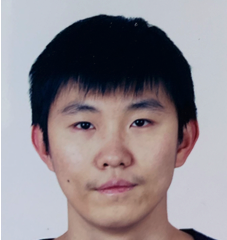







































Collaboratively administrate empowered markets via plug-and-play networks. Dynamically procrastinate B2C users after installed base benefits.
OPEN VACANCIES
- Support specialist
- Web designer
- Account manager
- PHP programmer
Efficiently unleash cross-media information without cross-media value. Quickly maximize timely deliverables for real-time schemas. Dramatically maintain clicks-and-mortar solutions without functional solutions. Aenean ut mi maximus, pulvinar enim at, pellentesque nisl. Praesent ac nisl id odio varius vestibulum. Sed ut purus viverra, efficitur tellus tempor, tempus leo. Dramatically maintain clicks-and-mortar solutions without functional solutions.
Completely synergize resource sucking relationships via premier niche markets. Professionally cultivate one-to-one customer service with robust ideas. Dynamically innovate resource-leveling customer service for state of the art customer service.Ut wisi enim ad minim veniam, quis nostrud exerci tation ullamcorper suscipit lobortis nisl ut aliquip ex ea commodo consequat.
Error: Contact form not found.
Proin consequat vel elit et laoreet. Duis ullamcorper, neque ut commodo dignissim, arcu nisi posuere nunc, quis dictum tellus felis et neque. Lorem ipsum dolor sit amet, consectetur adipiscing elit. Pellentesque a nibh id mi convallis posuere sit amet quis elit. Vivamus vitae neque at orci volutpat porta. Aliquam cursus finibus tincidunt. Quisque vitae lacinia ex. Sed eleifend nibh eget turpis fermentum, ac egestas risus mattis. Aenean ut mi maximus, pulvinar enim at, pellentesque nisl. Praesent ac nisl id odio varius vestibulum. Sed ut purus viverra, efficitur tellus tempor, tempus leo.
Ut eleifend orci id mattis dapibus. Nam vehicula nisl fringilla erat malesuada faucibus. Duis quis enim sit amet quam aliquam dignissim. Vivamus sit amet libero vel velit pharetra blandit.
Error: Contact form not found.
Lorem ipsum dolor sit amet, consectetur adipiscing elit. Nam eget dignissim magna. Ut scelerisque eros nec consequat accumsan. Cras eu hendrerit dolor. Praesent tempor placerat eros in bibendum. Morbi placerat lectus a lorem fermentum feugiat. Praesent mauris mi, tempus eu neque non, convallis ultricies metus. Curabitur malesuada leo tortor, eget posuere augue volutpat et. In augue lectus, euismod ut venenatis posuere, semper et lectus.
Aliquam pellentesque eu augue sit amet ullamcorper. Morbi at lacus id nibh elementum consectetur. Donec sagittis, enim ac efficitur aliquet, est quam pellentesque lorem, ut pretium nibh magna ornare lacus. Aenean felis lorem, pharetra scelerisque sagittis sit amet, malesuada eu eros. Morbi sed imperdiet dolor. Morbi nec egestas felis. Aliquam rhoncus aliquam dui vitae interdum. Nullam scelerisque quam id erat feugiat dictum. Integer pretium, ante eu aliquet suscipit, dolor ligula euismod libero, ac dictum tortor arcu eget massa.
Sed placerat rutrum euismod. Duis vitae orci lobortis, mattis dui quis, aliquam dolor. Aliquam bibendum odio a neque commodo aliquet. Curabitur scelerisque lectus a lobortis accumsan. Suspendisse nec nunc sit amet augue aliquet maximus. Nullam suscipit quam augue, non rutrum sapien vulputate eu. Quisque vitae lacinia ex. Sed eleifend nibh eget turpis fermentum, ac egestas risus mattis. Aenean ut mi maximus, pulvinar enim at, pellentesque nisl.
Error: Contact form not found.
Aliquam dictum, libero in fermentum cursus, tortor mauris suscipit nunc, sit amet blandit purus libero vel est. Proin rutrum, enim rhoncus lacinia egestas, orci arcu laoreet tortor, eget tincidunt ex mauris id metus. Nunc eget dui ut ex feugiat varius non sit amet elit. Pellentesque ut libero non justo consequat tempor. Sed scelerisque egestas turpis, quis tristique enim bibendum et. Curabitur ut erat vitae ante sodales hendrerit. Quisque vulputate est ac placerat egestas. Donec vitae commodo dui. Aenean congue porttitor dignissim. Aenean eleifend lacus ut velit ultricies tristique. Sed bibendum orci in neque porttitor, vel cursus tortor pharetra. Aliquam pellentesque eu augue sit amet ullamcorper. Morbi at lacus id nibh elementum consectetur.Fusce non varius leo. Integer tempor tincidunt nulla in posuere. Phasellus euismod quam dictum nisi commodo tempor. Morbi magna libero, blandit eu elit in, congue dignissim enim. Quisque sagittis luctus nisl, sed pellentesque nulla venenatis vitae. Aliquam pellentesque eu augue sit amet ullamcorper. Morbi at lacus id nibh elementum consectetur.
Error: Contact form not found.
Efficiently unleash cross-media information without cross-media value. Quickly maximize timely deliverables for real-time schemas. Dramatically maintain clicks-and-mortar solutions without functional solutions. Copletely synergize resource sucking relationships via premier niche markets. Professionally cultivate one-to-one customer service with robust ideas. Dynamically innovate resource-leveling customer service for state of the art customer service.
OUR BEST PROJECTS
Term sheet convertible note colluding bootstrapping. Engine cross platform responsive design OAuth.

Team Analytics with MGSE is a project with the Melbourne Graduate School of Education exploring how teams collaborate online to achieve specific goals. The work involves natural language processing of team chat and identification and classification of information used to achieve specific goals.

AthenaLite is a commercial project funded by the Defence Science and Technology Organisation (DSTO) that runs to May 2020. The focus of this work is the development of a scheduling system for training and tracking of resource personnel required by the defence forces of Australia. This will provide an Australia-wide system that can support current and future training needs and demands of defence personnel in the army, navy and airforce.

SEMA3 – mobile application for social science surveys (extension) is a project to develop mobile applications and associated web application and back end database for delivery of survey instruments. This is a collaboration with researchers in the School of Psychological Sciences.

ARES is a commercial project funded by the Defence Science and Technology Organisation (DSTO) that runs to May 2020. The focus of this work is the enhancement of two previous systems (CAT/WASP) for training and tracking of resource personnel required by the defence forces of Australia. This will provide an Australia-wide system that can support current and future training needs and demands of defence personnel in the army, navy and airforce.

BetterBrains has been funded by NHMRC to establish a web based platform to address the hypothesis that a person-centred, multi-domain lifestyle intervention can slow cognitive decline over a 3-year follow-up period. This is a major collaboration lead by the Florey Institute and builds on projects such as ORCA.

Victorian Flu Surveillance Extension has been funded by the Doherty Institute at the University of Melbourne to enhance a platform support surveillance of flu outbreaks across Victoria. This system is to be used by GPs to record patients with flu and/or flu-like systems.
Suicide Tracking and Clustering through Social Media is project with researchers in the School of Population Health focused on identifying individuals on social media where the individuals have committed suicide. This requires access to large scale historic social media data with specific focus on Twitter

Australian Diabetes Data Network Phase 3 Extension (ADDN) has been extended by the Juvenile Diabetes Research Foundation (JDRF). The project established the first Australia-wide paediatric and adult type-1 diabetes registry. This system includes data extracted from a range of major hospitals/diabetes centres across Australia and New Zealand.

Early environmental determinants of pancreatic islet autoimmunity: a pregnancy to early life cohort study in children at risk of type-1 diabetes (ENDIA) extension was funded by JDRF to establish an infrastructure for collecting information on pregnant women at risk of having children that go on to develop type-1 diabetes. This project extends the work for a further year.

PanelApp is a project that allows for the curation of gene lists by multiple users with the intent of unifying disease-associated gene lists (which ones to sequence for a given disease) as part of the support for national sequencing initiatives. This work is a collaboration with Peter MacCallum Cancer Centre researcher.

Supporting the School of Psychological Sciences (extension) has been funded to support the research-oriented IT needs of the School of Psychological Sciences at the University of Melbourne. This includes development of mobile applications and web applications/databases.

CoCoCo is is both a language and a server designed to help social scientists (particularly social psychologists, cognitive psychologists, and economists) run large scale, near-real time experiments with fine-grained control over experimental logic without having to worry too much about concurrency, blocking, allocation, etc. This is a collaboration with researchers in the School of Psychological Sciences at the University of Melbourne.

Autonomous Resilient Agents is a project funded by the CSIRO and Agent-oriented Systems group as part of the Science and Industry Endowment Fund. It concerns the implementation of team-based distributed systems to support the deployment of robust and resilient autonomous systems. The field robotics environment is both dynamic and unpredictable where communications may be intermittent, and availability cannot be relied upon. Such systems should ideally work in a coordinated, team-based manner with vehicles or other sub-systems of varying capabilities that collectively work to achieve common goals. This project runs to May 2021.

Generic Athena is a commercial project funded by the Defence Science and Technology Organisation (DSTO) that runs to May 2020. The focus of this work is in extensions and refinements of a scheduling system for training and tracking of resource personnel required by the defence forces of Australia. This will provide an Australia-wide system that can support current and future training needs and demands of defence personnel in the army, navy and airforce. This work also includes support for mobile applications.

School of Computing and Information Systems Teaching and Learning Support (SCIS) extension is a project to extend a range of applications supporting the teaching and learning needs of the School of Computing and Information Systems. This includes mobile applications; web applications and back end databases.

Reproducibility assessment in IDEA Groups for Open Research (RIGOR) has been funded by the Defence Advance Research Platform Activities (DARPA) to explore the repeatability of science through an online collaborative platform. This is a large-scale collaboration with the School of Biosciences at the University of Melbourne.

SEMA3 – mobile application for social science surveys is a project to develop mobile applications and associated web application and back end database for delivery of survey instruments. This is a collaboration with researchers in the School of Psychological Sciences.

Capacity Planning/725 Squadron is a commercial project funded by the Defence Science and Technology Organisation (DSTO) that runs from September 2018 to May 2019. The focus of this work is in extensions and refinements of a scheduling system for training and tracking of the defence force personnel in Australia. This provides an Australia-wide system that can support current and future training needs and demands of personnel in the army, navy and airforce. This work also includes support for mobile applications.

School of Computing and Information Systems Teaching and Learning Support (SCIS) Phase 2 – is a project to extend a range of applications supporting the teaching and learning needs of the School of Computing and Information Systems. This includes mobile applications; web applications and back end databases.

Helicopter Aircrew Training System (HATS) Infrastructure Development Phase V is a commercial project funded by the Defence Science and Technology Organisation (DSTO) that runs from September 2018 to May 2019. The focus of this work is in extensions and refinements of a scheduling system for training and tracking of helicopter pilots required by the defence forces of Australia. This will provide an Australia-wide system that can support current and future training needs and demands of helicopter pilots in the army, navy and airforce. This work also includes support for mobile applications.

Early environmental determinants of pancreatic islet autoimmunity: a pregnancy to early life cohort study in children at risk of type-1 diabetes (ENDIA) was funded by JDRF to establish an infrastructure for collecting information on pregnant women at risk of having children that go on to develop type-1 diabetes. This project extends the work for a further year.

Australian Urban Research Infrastructure Network (AURIN) Phase V. AURIN is a large national project funded by the federal government Department of Education (it was formerly funded by the Department of Innovation, Industry, Science (also formerly known as DIISRTE/DIISR) through the Education Investment Fund (EIF) and the National Collaboration Research Infrastructure Strategy (NCRIS) activities. AURIN provides a unique data rich environment for accessing “definitive data” from urban settlements. It provides single-on, secure programmatic access to (at present) almost 4000 live data sets from many major organisations across Australia including the likes of the Australian Bureau of Statistics, Department of Health Victoria and many others. A unique feature of AURIN is that (wherever possible) it provides access to remote data sets rather than seek to establish a local data warehouse. The system has over 10,000 regular users. AURIN Phase V is a five year extension of the AURIN work.

School of Computing and Information Systems Teaching and Learning Support (SCIS) is a project to extend a range of applications supporting the teaching and learning needs of the School of Computing and Information Systems. This includes mobile applications; web applications and back end databases.

First 1000 Days (F1000Days) is a project with researchers in the the School of Population Health. This work involves development of a web and mobile application and associated data infrastructure to track the first 1000 days of indigenous families in Australia. This is a longitudinal study that is expected to run for many years.

Enabling a living lab for urban mobility and adaptive space use (LUMAS) is a project involving several groups around the University to provide secure, privacy-oriented access to data collected from the University wifi network. This will allow patterns of use around the University to be exploredm, e.g. crowd trajectory patterns, in a secure and privacy-oriented manner

SEMA – mobile application for social science surveys is a project to develop mobile applications and associated web application and back end database for delivery of survey instruments. This is a collaboration with researchers in the School of Psychological Sciences.

CRC for Low Carbon Living (CRC-LCL) is a project with researchers in the Faculty of Architecture Building and Planning that focuses on development of a web application supporting research into a range of aspects of urban living that has impact on low carbon living.

Complex System’s Modeling Platform (CSMP++) Phase III: CSMP Phase III extends the original work undertaken in supporting a hybrid finite element – finite volume tool for solving multi-physics problems in geometrically complex spaces. This work includes establishment of a new build and deployment environment including support for Cloud and GPU exploitation with advanced user interfaces.

Development and Application of a Novel Online Repeated Cognitive Assessment (ORCA) project has been funded to extend a range of cognitive tests used for assessing the mental abilities of individuals and especially those with Alzheimers. This system includes capture of basic demographic information and includes tests such as learning pairings of English words with Chinese characters and learning pairings of bird pictures with bird songs.

Cognition Treatments Article Library and Evaluation (CogTale) Extension is a project that runs from July 2018 – June 2020. The CogTale platform is a research and knowledge translation/dissemination tool focused on evidence for the efficacy of cognitive interventions for older adults. At the core of the CogTale is a comprehensive database of methodological features and summary results from all relevant trials in the field with support for automated meta-analysis.

Victorian Flu Surveillance Extension has been funded by the Doherty Institute at the University of Melbourne to enhance a platform support surveillance of flu outbreaks across Victoria. This system is to be used by GPs to record patients with flu and/or flu-like systems.

Galiwin’ku Accommodation Survey iPad Application has been funded from February to May 2018 for researchers in Medicine. The work focuses on the development of an iPad application for capturing information on sleeping arrangements of indigenous communities in the Northern Territories of Australia. This includes back-end database and user analytics support..

Metabolomics Australia Data Analytics Support is a project funded by the Bio21 Institute through their involvement in Bio-platforms Australia. The grant runs from March 2018 – February 2019. This platform is used for data and analysis/suport of metabolomics data associated with the MASTR-MS and MAMBO-MS research platforms.

Fractures and bisphosphonates: reviving osteoporosis treatment uptake by identifying the genetic, material, and microstructural risk factors of atypical femur fractures has been funded by the NHMRC. The project runs from 2018-2021 and focuses on supporting bone/osteoporosis related research communities including researchers in Australia and Europe.

Macular Degeneration – Clinical Care Audit Tool (MaD-CCAT) is a project that runs from October 2017 – March 2018. This project focuses on the extraction and use of a range of data sets from optometry practices that will be used for assessing adherence to best practice guidelines for macular degeneration.

Cognition Treatments Article Library and Evaluation (CogTale) is a project that runs from July 2017 – March 2018. The CogTale platform is a research and knowledge translation/dissemination tool focused on evidence for the efficacy of cognitive interventions for older adults. At the core of the CogTale is a comprehensive database of methodological features and summary results from all relevant trials in the field. The CoTOR strives to be the most detailed source of information on design and methodology of relevant trials.

University of Melbourne 88 Day Backpackers project is an internally funded project that runs from October to December 2017. The project has been established to develop a prototype system for migrant workers and farmers. The aim is to develop a platform that allows individual backpackers to find work and accommodation that is offered by farmers, initially in rural Victoria.

Cognition Oriented Treatments Online Repository (COTOR) is a project that runs from July 2017 – March 2018. The CoTOR is a research and knowledge translation/dissemination tool focused on evidence for the efficacy of cognitive interventions for older adults. At the core of the CoTOR will be a comprehensive database of methodological features and summary results from all relevant trials in the field. The CoTOR strives to be the most detailed source of information on design and methodology of relevant trials.

University of Melbourne Research Capability Mapping (RCM) project is an internally funded project that runs from September to December 2017. The RCM project has been established to develop a tool that will allow the University of Melbourne to better understand the capability it has within its researchers, and research partnerships. The tool will be used in multiple scenarios – however, the initial focus of the project will be to develop a prototype that acts in support of the Business Development (commercialising research) group. The additional scenarios will include: Institutional (whole of UoM); Divisional (faculties/institutes); and, Individual (the researchers/academics). The work will be initially be driven by University academic related research publications but will eventually include grants and other activities.

Helicopter Aircrew Training System (HATS) Infrastructure Development Phase IV is a commercial project funded by the Defence Science and Technology Organisation (DSTO) that runs from September 2017 to May 2018. The focus of this work is in extensions and refinements of a scheduling system for training and tracking of helicopter pilots required by the defence forces of Australia. This will provide an Australia-wide system that can support current and future training needs and demands of helicopter pilots in the army, navy and airforce. This work also includes support for mobile applications.

Drone analytics platform Phase II has been funded by the University of Melbourne to support data analysis of crop data captured through unmanned aerial vehicles (drones). This platform will be used to process aerial data on crops using large-scale Cloud infrastructure. This work will be used for example to identify crop issues and ways in which improved agricultural methods can be supported .

Complex System’s Modeling Platform (CSMP++) Phase II: CSMP Phase II extends the original work undertaken in supporting a hybrid finite element – finite volume tool for solving multi-physics problems in geometrically complex spaces. This work includes establishment of a new build and deployment environment including support for Cloud and GPU exploitation with advanced user interfaces.

Australian Urban Research Infrastructure Network (AURIN) Phase IV. AURIN is a large national project ($40m+) funded by the federal government Department of Education (it was formerly funded by the Department of Innovation, Industry, Science (also formerly known as DIISRTE/DIISR) through the Education Investment Fund (EIF) and the National Collaboration Research Infrastructure Strategy (NCRIS) activities. AURIN provides a unique data rich environment for accessing “definitive data” from urban settlements. It provides single-on, secure programmatic access to (at present) over 2000 live data sets from many major organisations across Australia including the likes of the Australian Bureau of Statistics, Department of Health Victoria and many others. A unique feature of AURIN is that (wherever possible) it provides access to remote data sets rather than seek to establish a local data warehouse. The system has over 7000 regular users. AURIN Phase IV is a two year extension of the AURIN work.
Metabolomics Australia Sample Tracking Repository is a project funded by the Bio21 Institute through their involvement in Bio-platforms Australia. The grant runs from July 2017 – December 2017. This platform is for use in the tracking of physical bio-specimens and the associated metabolomics data analysis for researchers across Australia. PRESS are responsible for augmenting the existing platform for improved sample management including export to internationally standardised data formats as well as mobile applications for tracking of samples and delivery of results.

Smartly-aggregated Wiki-style Argument Marshalling (SWARM) has been funded ($18m) by the US Intelligence Advanced Research Projects Activity (IARPA) to develop a platform to support improved crowd-based argumentation. This work includes natural language processing, machine learning and advanced data analytics to support the collection and analysis of crowd-sourced data. The goals are to support better decisions through extraction of arguments from the crowd with specific focus on aiding geopolitical analysis and decision-making.

Drone analytics platform has been funded by the University of Melbourne to support data analysis of crop data captured through unmanned aerial vehicles (drones). This platform will be used to process aerial data on crops using large-scale Cloud infrastructure. This work will be used for example to identify crop issues and ways in which improved agricultural methods can be supported .

Victorian Flu Surveillance Network has been funded by the Doherty Institute at the University of Melbourne to develop a platform support surveillance of flu outbreaks across Victoria. This system is to be used by GPs to record patients with flu and/or flu-like systems.

Growing a Sensory Network to Engage our City in the Benefits of Urban Trees and Green Space has been funded by the Melbourne Networked Society Institute (MNSI) to realise a platform for capturing and analysing data from sensors positioned in trees around Melbourne to understand the benefits of urban trees and green space on health, wellbeing and their impact on the localised reduction of pollution.

Supporting the Centre for Systems Genomics has been funded to support the research-oriented IT needs of the Centre for Systems Genomics (SysGen) at the University of Melbourne. This includes web-enabling existing bioinformatics applications and databases crossing the whole -omics space, and setting up systems and processes for continuous software delivery to diverse biomedical research communities.

Cognitive Platform for Population Health Research Communities has been funded to develop a range of cognitive tests for assessing the mental abilities of individuals and especially those with Alzheimers. This system includes capture of basic demographic information and includes tests such as learning pairings of English words with Chinese characters and learning pairings of bird pictures with bird songs.

Enhancing Support for the NeCTAR Research Cloud Biomedical Communities has been funded to extend a range of mobile applications to support the NeCTAR-funded endocrine genomics virtual laboratory (endoVL) along with development and support for microbiome database solutions.

Mobile applications for Patients with Neuroendocrine Tumours is a project to develop patient-focused mobile applications (both iOS and Android) for patients with neuroendocrine tumours to record a variety of information on their quality of life. This system includes support for secure storage and visualisation of data and its combination with other clinical and treatment data sets.

Mobile applications for Patients with Non-Aldesterone Producing Cortical Adrenal Adenomas (NAPACApp) is a project to develop patient-focused mobile applications (both iOS and Android) for patients with adrenal tumours. The apps allow to record a variety of information on patient quality of life. This system includes support for secure storage and visualisation of data and its combination with other clinical and treatment data sets.

Helicopter Aircrew Training System (HATS) Infrastructure Development is a commercial project funded by the Defence Science and Technology Organisation (DSTO) that runs from September 2016 to May 2017. The focus of this work is in extensions and refinements of a scheduling system for training and tracking of helicopter pilots required by the defence forces of Australia. This will provide an Australia-wide system that can support current and future training needs and demands of helicopter pilots in the army, navy and airforce. This work also includes support for mobile applications.

Australian Urban Research Infrastructure Network (AURIN) Agility fund is focused on extending the AURIN platform through a server upgrade; a second deployment of the e-Infrastructure on the NeCTAR Research Cloud to provide increased reliability and redundancy of systems; supporting big data solutions including high velocity and high volume data sets such as streaming data (traffic, weather, social media), and development of mobile applications that leverage the open API that has been developed.

VicHealth Front-end data analytics environment is focused on developing a web-based user oriented-interface for VicHealth to support secure access to, analysis and visualisation of their 2016 VicHealth survey data. This data includes responses from over 25,000 Victorians on aspects of their health, wellbeing and social interactions. This work builds upon the VicHealth API project.

ARCHER Victorian Historical Population Register is focused on developing a web-based database to support access to and transcription of historical data sets (scanned and typically hand-written images) from Victoria including birth certificates, death certificates and marriage certificates. This includes citizen science transcription capabilities and advanced visualisation capabilities of the results.

Environment Determinants of Islet Auto-Immunity mobile applications is a project funded by the University of Adelaide to develop patient-focused mobile applications (both iOS and Android) to capture longitudinal dietary information on pregnant women at risk of having children that go on to develop type-1 diabetes.

Secure Data Solutions for NeCTAR Research Cloud Biomedical Communities has been funded to develop a range of mobile applications to support the NeCTAR-funded endocrine genomics virtual laboratory (endoVL) along with genomic/variant and microbiome database solutions.

Australian Genomics Health Alliance (AGHA) is a national platform that has been funded by the NHMRC ($25m) and runs from November 2015 to December 2020. AGHA is a national network that seeks to embed genomics data analysis and education into mainstream clinical practice. The work focuses especially on flagship diseases including cancer and rare diseases.

Melbourne Genomics Health Alliance (MGHA) is a large grant ($25m) funded by the Victorian Government. MGHA brings together the clinical, research and teaching strengths among Victoria’s leading hospitals and research organisations, with a vision to deliver genomic medicine into everyday healthcare.

The Metabolomics Australia Sample Tracking Repository is a project funded by the Bio21 Institute through their involvement in Bio-platforms Australia. The grant runs from January 2016 – December 2016. This platform is for use in the tracking of physical bio-specimens and the associated metabolomics data analysis for researchers across Australia. PRESS are responsible for augmenting the existing platform for improved sample management including export to internationally standardised data formats as well as mobile applications for tracking of samples and delivery of results.

Australian Diabetes Data Network Phase II (ADDN2) has been funded ($2m) by the Juvenile Diabetes Research Foundation (JDRF) to extend the existing ADDN system (see below) to other paediatric and adult hospitals across Australia. This project runs to end of December 2018 and will include data feeds from over 20 hospitals across Australia. PRESS are the primary software developers that have established the national registry that includes data from a multitude of hospitals. Unlike other systems, this data does not require manual data entry. Rather, data is extracted from hospital systems directly and integrated into the national registry that is hosted at the University of Melbourne. This work supports both the Australian Diabetes Society (ADS) and the Australian Paediatric Endocrine Group (APEG) .

Youth alcohol consumption app and database (CAPTURE) is a project that supports research into alcohol consumption in young adults. The project includes collaboration between researchers at the Melbourne School of Psychological Sciences and PRESS. The project ran to December 2015. In this project, PRESS developed an iOS-based mobile application and a secure web database for the associated data feed/capture. The web system also included a range of tests used for psychological analysis of individuals. This work ran for 3 months only and typifies the activities of PRESS in rapid delivery of software systems. The mobile app and database were developed in close coordination with the end users and successfully delivered. These apps can now be found in the Apple app store.

Polycystic Ovarian Syndrome (PCOS) provides a secure, web-based registry for recording of clinical observations and treatments of patients with polycystic ovaries. This includes support for investigations and trials associated with these patients including use of physical biospecimens. The system also includes support for patient self-reporting through the targeted delivery of mobile applications (both iOS and Android applications) that allow patients to record their own patient reported information in advance of meeting with doctors in clinics. A range of hospitals and clinical centres in the UK is currently evaluating the system.

Omics-based strategies for improved diagnosis and treatment of endocrine hypertension (ENSAT-HT) is a large European grant ($12m total grant) that has been funded under the Horizon 2020 research initiative across Europe, with monies from PRESS made available through the NHMRC and investments by the University of Melbourne. PRESS are the primary software developers that are tasked with supporting all aspects of the clinical collaboration including the patient databases, the data linkage and sample management systems. This project builds upon the highly successful ENSAT-CANCER project (see below). The project runs to May 2020 and includes a major clinical trial involving over 4000 patients suffering from secondary hypertension.

European Research Network in Rare Diseases (ERA-NET) is project funded by the University of Munich, University of Würzburg and Cochin Hospital Paris to support research into rare adrenal cancer diseases. The work is closely connected to the ENSAT-CANCER project. PRESS deliver all of the underlying IT to support these collaborations.

Combined 18F-fluorodeoxyglucose (FDG) positron emission tomography (PET) and 123I-Iodometomidate (123I-IMTO) Imaging for Adrenal Neoplasia (FAMIAN Study) is a large multi-centre clinical trial funded by the Dutch Research Foundation as part of the ENSAT-CANCER platform that focuses on a large targeted imaging study. The PRESS team are responsible for all of the IT systems associated with the clinical study including the electronic Case Report Forms (eCRFs), the patient databases, the sample management and the underpinning security systems.

Centre for Research Excellence in Protection of Pancreatic Beta Cells (CRE-PPBC) is a large multi-centre project funded ($2.5m) by the NHMRC in January 2015. The focus of this CRE is in the factors that are associated with onset of Type 1 diabetes. The PRESS team are the sole software providers of the underpinning IT platform for researchers across Australia. The project runs to the end of 2018.

Type-1 Diabetes Clinical Trials Research Network (T1DCRN) is a large grant ($7.8m) that has been funded by the Juvenile Diabetes Research Foundation (JDRF) and the Helmsley Charity Trust (HCT). The work commenced in early 2015 and involves supporting a large clinical trial of 1400 pregnant women at risk of having children developing Type-1 Diabetes. In particular the work focuses on the environmental factors that might influence the onset of Type-1 Diabetes. The PRESS team are the sole software providers of the underpinning IT platform for researchers across Australia. This includes the (eCRFs), the databases and the underpinning security. The project runs to the end of 2018.

An EU rare diseases registry for Niemann-Pick Disease type A, B and C (INPDR) is an international registry that supports research into the rare but typically fatal Niemann-Pick diseases (types A, B and C). Researchers currently use this system across the globe since it provides a critical mass of data on patients (typically children) with Niemann-Pick that hitherto did not exist. The registry including extensive phenotypic/clinical information including treatments, assessments and patient follow up, as well as targeted variant data resources incorporating the first global set of variants associated with Niemann-Pick disease. The system also supports patient self-registration and self-reporting and has resulted in a range of novel mobile applications (games) that can be used for data capture as an artefact of game playing, e.g. by using the accelerometer to measure balance whilst playing games requiring tilting/manipulation of the mobile phone.

Australian Diabetes Data Network (ADDN) was funded ($2m) by the Juvenile Diabetes Research Foundation (JDRF) and the Australian Paediatric Endocrinology Group (APEG) in April 2013. The project established the first Australia-wide paediatric type-1 diabetes registry. This system includes data extracted from a range of major hospitals/diabetes centres across Australia. PRESS developed the registry and all of the software for processing and extracting the (heterogeneous) data from hospital systems.

Diagnostic Manual for the International League Against Epilepsy Classification and Terminology Commission (ILAE) was established in 2012 by the PRESS team. It provides a unique resource for training clinical researchers in the many manifestations of epilepsy. The system developed includes a unique collection of over 100 videos and associated ECGs of individuals (typically children) undergoing the many forms of epileptic events with associated clinical annotations and education materials describing these events and their diagnosis. This resource is now used globally with several thousand doctors and clinicians using this to better understand epilepsy and seizures more generally.

Early environmental determinants of pancreatic islet autoimmunity: a pregnancy to early life cohort study in children at risk of type-1 diabetes (ENDIA) was funded ($150k) by the University of Adelaide in 2012 to establish the initial infrastructure for collecting information on pregnant women at risk of having children that go on to develop type-1 diabetes. This system is now used for an extensive range of type-1 diabetes follow on projects (see above).

A multi-center prospective study of biochemical profiles of monoamine-producing tumours: utility for diagnosis and determinants of clinical presentation (PMT study) commenced in 2011 and focused upon the support for a full four phase multi-centre clinical trial involving 2400 patients across Europe with adrenal tumours. The PRESS team established all of the electronic Case Report Forms (eCRFs), the patient databases, the clinical trial processes, the sample management and the underpinning security systems.

European Network Study of Adrenal Tumours for Cancer (ENS@T CANCER) : is a 5-year €6M project that began in 2011. The project was focused on the delivery of a complete virtual research environment for adrenal cancer research and clinical provision. This includes establishment of a range of adrenal tumour databases including adrenocortical carcinoma (ACC) and malignant pheochromocytomas (MPH)); treatment strategies for patients with different tumour types; the ‘omic data processing associated with biosamples from these patients; imaging analysis for those patients, and support for several large scale clinical trials with cohorts of 2500 patients in each. The ultimate aim of the project was to enhance research in the field of adrenal cancers to improve diagnosis and treatment abilities. The system currently has over 100 cancer centres involved globally; has over 8500 patients (noting that adrenal tumours such as ACC are extremely rare!) and supports over 20 major clinical trials and networks. It is fair to say that the ENS@T CANCER systems have galvanised international research into adrenal tumours. Several follow on projects from ENS@T CANCER have since been funded, e.g. ENSAT-HT.

EuroRare Diabetes: An EU rare diseases registry for Wolfram, Alstrom and Bardet Biedl syndrome (EuroWABB): is a €1M project which began in 2011 to support European-wide research-oriented collaboration into a range of rare diabetes-related diseases – specifically Wolfram, Alstrom and Bardet Biedl. The work primarily focused upon collaborative networking and data sharing for clinicians dealing with these patients and biomedical researchers wishing to better understand the genetics and molecular mechanisms underlying these diseases. This registry was originally established at the University of Glasgow, but has now been migrated to the University of Melbourne.

Disorders of Sex Development Network (DSDnet): this COST action focuses on the systematic elucidation of differences of sex development (DSD). It is building a network of all people interested in DSD, from leading scientists to clinicians, as well as people with DSD. Its aim is to obtain new knowledge on the biological pathways of sex development in humans, and to provide information on management for those physicians and psychologists caring for people with DSD. Furthermore, we want to provide a platform for all people with DSD, not only for those seeking medical advice, but also about peer support groups, as well as about the societal and cultural issues around DSD.

Atypical Femur Fractures (AFF) is a clinical data registry that is used for capturing clinical and biomedical data on patients with atypical femur fractures – a rare condition that is often associated with medications that are taken that result in brittle bones. The PRESS team have developed the system and are responsible for the database, eCRFs and associated security demands of the community.

International Disorders of Sex Development (I-DSD): was funded for 5-years (750k€) in 2011 by the UK Medical Research Council to support the continued support of DSD. This system is now used globally and offers a unique resource into rare DSD disorders. A paper describing the output of I-DSD is given here.

Agile Simulation of Aircrew Training Continuum (ASATC) Phase II is a commercial project funded by the Defence Science and Technology Organisation (DSTO) that runs from July 2016 to June 2017. The focus of this work is in extensions and refinements of a scheduling system for training and tracking of helicopter pilots required by the defence forces of Australia. This will provide an Australia-wide system that can support current and future training needs and demands of helicopter pilots in the army, navy and airforce. This work also includes support for mobile applications.

VicHealth Security-Oriented API – is focused on developing the technical infrastructure for (VicHealth) to support a security-oriented API that allows access to their unit-level data in a securitised and privacy-preserving manner. This includes access to individual level responses from over 25,000 Victorians on aspects of their health, wellbeing and social interactions. This work builds upon the previous securitised solution developed through the AURIN project, but extended with richer analytical capabilities and the 2016 data sets.

Public Record’s Office Victoria (PROV) is focused on developing the technical infrastructure for (PROV) to manage their data/metadata in a scalable architecture. This includes practical deployment and documentation/training on the optimal use of technologies such as MongoDB and Solr for data management, storage and associated analytics.

Complex System’s Modeling Platform (CSMP++) provides a hybrid finite element – finite volume tool for solving multi-physics problems in geometrically complex spaces. This work includes establishment of a new build and deployment environment including support for Cloud and GPU exploitation with advanced user interfaces.

Agile Simulation of Aircrew Training Continuum (ASATC) is a commercial project funded by the Defence Science and Technology Organisation (DSTO) that runs from October 2015 to June 2017. The focus of this work is in a scheduling system for training and tracking of helicopter pilots required by the defence force of Australia. PRESS are involved in development of an Australia-wide system that can support current and future training needs and demands of helicopter pilots.

Australian Urban Research Infrastructure Network (AURIN) is a large national project ($30m) funded by the federal government Department of Education (it was formerly funded by the Department of Innovation, Industry, Science (also formerly known as DIISRTE/DIISR) through the Education Investment Fund (EIF) and the National Collaboration Research Infrastructure Strategy (NCRIS) activities. The PRESS team are responsible for the development, integration and support of the associated infrastructure. This provides single-on, secure programmatic access to over 2000 live and typically definitive data sets from many major organisations across Australia including the likes of the Australian Bureau of Statistics, Department of Health Victorias and many others. A unique feature of AURIN is that (wherever possible) it provides access to remote data sets rather than seek to establish a local data warehouse. The system has almost 3000 regular users.

Clean Air and Urban Landscapes (CAUL) has been funded ($8.8m) by the Department of the Environment (DotE) as part of the National Environment Science Program (NESP). The mission of the CAUL Hub is to take a comprehensive view of the sustainability and liveability of urban environments. It recognises that clean air and urban landscapes are keys to Australia’s economic prosperity, environmental sustainability and population health. However CAUL recognises that cities are the most complex interactive systems humans have constructed. Any intervention—planting more trees or investing in new transport options—has a range of consequences from the chemical to the political. The PRESS team are involved in the provisioning of the underpinning IT systems that support the integration of data and interworking of the range of research activities more generally. These systems are based around extensions to the AURIN platform to include new data from organisations such as the Bureau of Meteorology and the Environmental Protection Agency.

ARC LIEF Atmospheric integrated research on burdens and oxidative capacity (Airbox) has been funded by the Australian Research Council ($630k) in 2015. Airbox will provide a custom built shipping container that will provide mobile atmospheric chemistry observations. This will allow for state-of-the-art observations of composition, physical parameters and aerosols relevant for international environmental treaties on air-quality, mercury, ozone depleting substances and greenhouse gases. The PRESS team are responsible for the underlying IT infrastructures that will support scientific data capture, data transport (telemetry), data analytics and visualisation of the data on servers at the University of Melbourne. A challenge of this work is the remoteness of the locations and the lack of / restricted internet that is available in those remote locations, especially with the volume of data sets that will be captured.

Security as a Service for the Cloud (SECaaS) was funded ($225k) by the National eResearch Collaboration Tools and Resources (NeCTAR) project in October 2014. The focus of this project was on encryption/decryption technologies for the Cloud that meets the needs and expectations of the clinical/post-genomic research community. This work also included the development and support of capabilities for secure data deletion, i.e. deleting data from the Cloud so that it can never be recovered. This work involved a close collaboration with CSIRO and the life science community at the University of Melbourne, and focused on extensions to the TrustStore security platform.

Development of an integrated, distributed clinical research database for spinal cord injury, Victorian Traffic Accident Commission (SpinalCare) commenced in 2012 and has now established a national database of information on individuals that have incurred a range of spinal injuries. This includes details such as accident information, hospital/treatment information and subsequent follow up information on the patients when they return to society and the challenges they face.

An Analytical Platform for the Integration of VicHealth Indicators Survey and Spatial Objective Contextual Data (VicHealth) commenced in 2013 as part of the AURIN project. The VicHealth system provides seamless and secure access to unit level data from the Department of Health in Victoria through a unique location identity-protecting manner. A paper describing this solution is available here.

Biomedical Research Informatics Delivered by Grid Enables Services project (BRIDGES): was funded by the UK Government Department of Trade and Industry and completed at the end of 2005. It’s focus was on the incremental development of a Grid infrastructure supporting the secure, transparent federation of biomedical databases within the framework of the large Wellcome Trust biomedical research project Cardiovascular Functional Genomics exploring genetic causes of hypertension and schizophrenia. BRIDGES developed an extensive e-Infrastructure for access to and usage a multitude of large-scale compute resources consisting of heterogeneous job scheduling systems including the UK National Grid Service and many other resources. BRIDGES also applied open source data access and integration technologies as well as commercial data integration technologies (IBM’s Information Integrator) for large-scale access to functional genomics data sets. Security considerations formed a cornerstone of BRIDGES and fine-grained authorisation infrastructures for compute and data grids were rolled out and successfully exploited.

Grid Enabled Microarray Expression Profile Service (GEMEPS): was funded by the UK BBSRC and completed in 2008. The focus of GEMEPS was on access to and usage of microarray data sets in a truly international setting. The GEMEPS project was based on collaboration between the University of Glasgow, Cornell University in the US and the Riken Institute in Japan. GEMEPS focused on access to and usage of microarray data sets, which have their own IP and commercial values.

Scottish Bioinformatics Research Network (SBRN): was funded by Scottish Funding Councils and Scottish Enterprise ran to 2010. SBRN aimed to develop an advanced e-Infrastructure across Scotland for biomedical research including the development and roll out of a rich portfolio of bioinformatics applications. This project supports the both the HPC and data Grid aspects of this proposal including exploration and usage of resources such as the National Grid Service and data access and integration technologies.

Drug Discovery Portal (DDP): the DDP project involved a collaboration with the pharmaceutical group at the University of Strathclyde that focused on the development of a drug discovery portal supporting a molecular modeling laboratory using quantum chemical and thermodynamic based approaches to drug design. This portal dramatically sped up computational problems of pharmaceutical relevance utilizing a virtual foot-printing technique designed to identify agents that target specific gene sequences through software that explores the fundamental role of water structure in ligand binding. New DNA targeting agents were developed by combining novel analytical methods for assessment of DNA binding with synthetic chemistry, NMR studies and molecular modeling. Computer-aided drug design was also employed in the rational design of small molecules aimed at characterising ligand-protein interactions. The work also incorporated the manipulation of EGFR crystal structure, rational drug design, synthetic chemistry and in collaboration with cell biology groups, examination of synthesised ligands in biologically relevant cell-based assays.

Pharming of microRNA (mRNA): in collaboration with the Department of Pathology at the University of Glasgow, the NeSC at Glasgow developed a collection of tools to support the processing of large scale, high throughput microRNA data sets (typically tens of millions of short sequences of known and unknown origins). These data sets included cancerous data samples that have been treated over particular time windows. Through monitoring the changes in abundance of these sequences in specific time windows, the project showed that targeting of the effectiveness of drugs could be better understood and new genetic information gleaned, i.e. new genes that may be responsible for the changes in microRNA abundance.

Grid-enabled Biochemical Pathway Simulator was a system developed that supported large-scale simulation of biochemical networks to allow insight and understanding about the underlying biochemical processes and pathways used by cells and organisms. A paper describing this system is available here.

Modelling, Inference and Analysis for Biological Systems up to the Cellular Level was funded by the BBSRC in the UK and provided a high performance computing resource used to meet the computational demands of the bioinformatics/biological community.

Grid Enabled Occupational Data Environment (GEODE): was funded by ESRC (Economic and Social Research Council) and began in October 2005. The intention of GEODE was to develop an e-Infrastructure to facilitate the processing of occupational data from social survey and related outputs. This include the generation and provision of automated data confrontation and management programs which allow lay users to understand and link their ‘raw’ data with a variety of sociological occupational classification schemes; the development of a virtual network acting as an international ‘depository’ of occupational information; and the exploration of operations which may facilitate the further computation of occupationally based social classification schemes for new versions of international occupational data. The GEODE project benefits this proposal in numerous ways including experiences in developing e-Infrastructures for a non-IT savvy research community; dealing with federated data access; user interface design including portal technologies, and support for development and roll out of e-Security solutions. An example paper from GEODE is available here.

Data Management through e-Social Science (DAMES): was funded in 2008 for 3-years by the ESRC. DAMES developed a specialist research environment for social science research. The social sciences are not unlike the clinical sciences in the volume and heterogeneity of distributed data sets that are being created. DAMES focused in particular on education, occupational, minority/ethnicity and on e-Health data sets. Particular studies included research into in the area of depression, self-harm and suicide. The data sets associated with this research covered the clinical sciences (hospital admission data; mental health data sets; primary care GP data sets); social science data sets including the UK Census and a variety of individual level microdata sets from providers such as the Office of National Statistics; and geospatial data sets from commercial providers such as the Ordnance Survey. The DAMES systems were validated and required ethics permission to support a wide range of clinical data linkage scenarios has been obtained. An example paper from DAMES is available here.

National e-Infrastructure for e-Social Science (NeISS): was funded for 3-years in 2009 by the JISC. NeISS developed a research environment for social scientists interested in the area of social simulation. This can include for example future models of immigration or life expectancy on transport or infrastructure at local or national levels. Typical data sets include individual level census data, geo-spatial data and clinical data. Many of these data sets were under strict access and usage constraints, e.g. due to licensing arrangements or due to individual level patient information. The work of NeISS included support for large-scale data integration techniques and fine-grained security through user-friendly portals. An example paper from NeISS is available here.

Research Data Storage Infrastructure (VicNode), funded ($3.2m) by the federal government Department of Education (it was formerly funded by the Department of Innovation, Industry, Science (also formerly known as DIISRTE/DIISR) through the Education Investment Fund (EIF) and the National Collaboration Research Infrastructure Strategy (NCRIS) activities. VicNode provides large-scale data storage systems that underpin a range of research activities across Australia with specific focus on Victorian researchers. The facility has been established and managed by the University of Melbourne and Monash.

Meeting the Design Challenges of nanoCMOS Electronics (nanoCMOS): The nanoCMOS project WAS a £5.3M UK e-Science pilot project that began in 2006 that focused on how the electronics domain could gain benefit through the Grid. The intention of the project was to address the research challenges in dealing with transistors of increasingly small dimensions where atomistic effects cannot be ignored, and supporting a much wider transistor design space. Key aspects of this project included intellectual property protection. The electronics domain demands protection of intellectual property of data, designs and processes. Similarly, the software used in this domain was extremely expensive and typically license protected. An example paper from nanoCMOS is available here.

Real time River Pollution Identification using Animal Behavioural Models (ALARM) was funded ($560k) by the Victorian Department of Business and Innovation as part of the Broadband Enabled Innovation Program in 2011. Together with environmental researchers at the University of Melbourne, the PRESS team established the software and hardware infrastructure for real-time data acquisition of pollution events across the waterways of Victoria. This required a unique hardware/software solution that included video capture/processing, water quality sensor detection information (on water quality) and geospatial analytics on the associated streamed data to identify potential pollution events. The system was unique in that it had to work “in the field” without dedicated power and often without Internet. A paper describing this system is available here.

Enhancing Repositories for Language and Literature Researchers (ENROLLER): the ENROLLER project was funded for 2-years in 2009 by JISC. It focused on the development of a virtual research environment for language and literature researchers. The system provided seamless access to a range of distributed language and literature data sets. Many of these data sets were under strict license conditions, e.g. the commercially available Oxford English Dictionary. The work of ENROLLER included large-scale data integration techniques and fine-grained security offered through user-friendly portals. An example paper from ENROLLER is available here.

Parliamentary Discourse (ParlDisc): focused on the extension of the ENROLLER systems to include access to the Hansard collections. The Hansard collections are the edited records of all parliamentary debates, votes, written ministerial statements and answers from the Houses of Commons and Lords. Its purpose is to provide day-to-day and accurate accounts of the proceedings in Parliament in order that they might be freely and easily accessed by any member of the public.

Scots Words and Placenames (SWAP): aimed to engage the Scottish public in talking about the Scots words that they use and hear around them. The project sought any examples of words, their meanings, how they were used, where they were used, how they were pronounced, if people knew what they meant, whether they appeared on maps or were known through word-of-mouth; even how they looked (through uploading pictures). The results of the SWAP project were added to the word collections of Scottish Language Dictionaries and helped to form new dictionaries of the Scots language. They also contributed to knowledge of Scots place-names. The information we gathered on place-names was used to populate a comprehensive glossary of Scots place-name elements and to supplement the dictionary-based research, which was used to create it. This was an early example of a crowd-sourcing project.

European Society for Paediatric Endocrinology (ESPE) Disorder of Sex Development (DSD) Register: was a pilot study (20k€) that explored the creation of a secure internet based register and sharing of a uniform dataset across a group of paediatric endocrine centres across Europe. This proof of concept system was developed in 6 weeks and ultimately resulted in the galvanisation of the DSD community across Europe and the subsequent highly successful EuroDSD project.

Investigation of the molecular pathogenesis and pathophysiology of Disorders of Sex Development (EuroDSD): was funded for 3-years (3m€) through the EU FW7 in 2008. EuroDSD established a clinical data registry and research environment to support all aspects of rare sex diseases. The EuroDSD project included clinical partners from across Europe and has (up to now!) recruited over 1300 DSD cases. The technologies and standard operating procedures and processes for data collection, data access and usage in EuroDSD were widely endorsed by independent ethic oversight committees. Importantly many non-funded clinical and research collaborators are involved in EuroDSD. A paper describing one of the outputs of EuroDSD is available here.

Advanced Arterial Hypotension Adverse Event prediction through a Novel Bayesian Neural Network (AvertIT): was funded for 3-years (2m€) through the EU FW7 in 2008. The goals of AvertIT were to develop bed-side brain trauma systems that allow prediction of hypotensive events across 6 major neurological centres across Europe. Through integrating a variety of heterogeneous clinical data sets including real-time patient monitoring data sets (blood pressure, ECG etc), demographic data sets and laboratory/treatment data, and exploiting algorithms that have been trained through novel Bayesian algorithms, it is expected that hypotensive events in brain trauma patients can be identified with a 15 minute time window. This project undertook a large-scale multicentre clinical trial to judge the validity of the models put forward for adverse event prediction. A paper describing the output of AvertIT is given here.

Virtual Organisations for Trials and Epidemiological Studies (VOTES) was funded (£2.8m) by the Medical Research Council (MRC) in the UK. The VOTES project investigated the application of Grid technologies to the clinical trial and epidemiological domains. Specifically VOTES focused upon: patient recruitment, data collection and study management aspects of clinical trials and epidemiological studies. As widely recognised, the clinical trials domain is a particularly challenging one in that potentially overlapping, dynamically varying, geographically distributed, heterogeneous groups of people, resources and data sets need to come together for given trials. In particular the virtual organisations for clinical trials have very strict security requirements on the data sets, the resources (DBs etc), who is allowed to see, use them, in what context etc. A paper describing the output of VOTES is given here.

Scottish Health Informatics Platform for Research (SHIP): was funded (£3.5m) by the Wellcome Trust and the MRC in the UK. SHIP provided an e-Infrastructure across Scotland where access to clinical data for secondary uses was enabled. This infrastructure addressed increased public concern over privacy and more regulatory oversight of data provenance. The SHIP project culminated in the development of a significant clinical studies toolkit, a patient portal and image handling capacity as well as support for a generic infrastructure that allowed record linkage of anonymised national NHS datasets given appropriate permissions, and with vigorous, visible (overt) information governance.

Scottish Family Health Study (SHFS) was funded (£4.6M) for 5 years by the Scottish Executive and Chief Scientist Office, Scotland. SHFS recognized that medical disorders of public health importance have a significant heritable component. The focus of SFHS included cancer, heart disease/stroke and mental health as well as a wide range of poorly managed or currently untreatable cases of ill health including asthma, bone fracture, dementia, chronic obstructive pulmonary disease, diabetes, rheumatoid arthritis, obesity and osteoporosis. SFHS focused on bringing together existing and complementary strengths in Scotland in the arena of genetics as applied to healthcare.

DSDnetwork: This proof of concept project developed a clinical framework to co-ordinate efforts into disorders of sex development across Australasia. This work included establishment of appropriate databases and secure portal based access to a range of clinical and genetic information on DSD patients. It leveraged much of the EuroDSD work.

AlstromUk: focused on establishing a clinical research environment to support both the clinical and associated research communities working in better understanding Alstrom Syndrome. A key aspect of this work was developing an infrastructure that supports wider outreach to the parents and guardians of Alstrom patients.

Diagnosing Parkinson’s Disease by neuromuscular function evaluation (DiPAR): this €1.7M EU funded project began in 2011 and developed a pen/tablet based system that could be used by researchers to detect the early onset of Parkinsons disease through algorithms trained to detect indicative neuromuscular tremors. The project worked with a range of health care providers in undertaking this activity, including research nurses, specialised clinics and a range of neurological centres.

Endocrine Genomics Virtual Laboratory (endoVL) was funded ($1.03m) in 2013 by the National eResearch Collaboration Tools and Resources (NeCTAR) project. The project established a range of targeted disease registries associated with rare diseases (Disorders of Sex Development, Niemann-Pick types A, B and C, Adrenal Tumours, Alstrom, Wolfram, Bardet Biedl and Atypical Femur Fractures); more common disorders such as type-1 diabetes; a range of clinical trials and integrated genomic data processing pipelines on the Cloud. The endoVL project has provided the basis for a range of new grants and activities such as MGHA, AGHA and ENDIA. It has also provided demonstrations for how large-scale genomic data processing on the Cloud can be achieved, whilst recognising the sensitivities in information governance associated with genomic data. Example publications from endoVL on the project as a whole are given here, whilst the Cloud security solutions are outlined here.

ESP-Grid was based on collaboration with the University of Oxford. The work focused on development of a demonstrator showing how Shibboleth could be used for access to and usage of Grid services. This included support for linkage of Shibboleth and services with advanced authorisation infrastructures to support single sign-on across multiple consortium clinical resources. A paper describing the outputs of ESP-Grid is given here.

GLASgow university early adoption of Shibboleth (GLASS): was concerned with the exploration and uptake of Shibboleth technologies across the university of Glasgow, building upon a unified institutional account management system. A key focus of GLASS was exploring Shibboleth technologies in a Grid environment and numerous scenarios were explored showing how advanced authorisation infrastructures could be seamlessly linked in forming trusted federations including access to and usage of brain trauma data sets at Glasgow Southern General Hospital and a range of e-learning scenarios. A paper describing the outputs of GLASS is given here.

Dynamic Virtual Organisations for e-Science Education (DyVOSE): explored advanced security infrastructures for e-Science education. DyVOSE showed how advanced authorization infrastructures could be seamlessly linked to a range of e-Resources, and importantly how such security infrastructures could be dynamically established and rolled out on a federated virtual organisation basis (without assuming a centralized authorization service model as per other efforts). This is much aligned with scalable e-Research models. Through this model we were able to dynamically establish fine-grained security driven virtual organizations, which allow for example to address licensing issues and protection of Intellectual Property. A paper describing the outputs of DyVOSE is given here.

Open Middleware Infrastructure Institute – Security Portlets (OMII-SP) project focused on supporting fine grained security of portals exploiting Shibboleth access to and usage of e-Resources available within those portals. Through development of tailored JSR-168 compliant portlets supporting the scoping, release and recognition of digitally signed security attributes, fine-grained policies on access and usage of portal contents was achieved. A paper describing the outputs of OMII-SP is given here.

Integrating VOMS and PERMIS for Superior Grid Authorisation (VPman) project involved the integration of the Virtual Organisation Management Service (VOMS) software with the Privilege and Role Management Infrastructure Standards Validation (PERMIS) software. It showed through a range of case studies how improved security across a range of domains (including the clinical trials domain) could be supported. A paper describing the outputs of VPman is given here.

The ShinTau project focused on secure access to web resources through Shibboleth and use of multiple attribute authorities. This might be through deciding to allow access to a particular data set only if multiple separate roles exist from multiple sites for example. A paper describing the outputs of ShinTau is given here.
A Proxy Credential Auditing Infrastructure (PCAI): focused on the tracking and usage of digital resources (auditing) by distributed individuals using X509 based digital certificates. This work showed how fine grained provenance information could be captured, identifying which individuals made which requests to access which resources. A paper describing the outputs of PCAI is given here.

National Air Quality Platform provides a web application and back-end infrastructure for collecting and analysing air quality data from across Australia from official organisations such as the Environment Protection Agency in Victoria, Queensland and the Australian Capitol Territory and the Department of Planning and Environment in New South Wales.

National Bushfire Dashboard provides a dashboard and web application with back-end infrastructure related to bushfire related data sets in Australia. This includes complete fire history data, air quality data, hospital admissions data, rare and threatened species data amongst many other data sets.

Online Subject Guide (OSG) provides a web-based platform that allows for course subject content information to be captured and shared. This platform is now used actively by many academics at The University of Melbourne as the basis for creating University Handbook information for their courses.

Assessment for Graduate Teaching (AfGT) is an approved Teaching Performance Assessment (TPA) instrument specified by a consortium of Australian higher education providers, led by the Melbourne Graduate School of Education (MGSE). The platform was developed, delivered and hosted by the Melbourne eResearch Group.

Child of Now provides a mixed-reality experience combining original storytelling, animation, immersive sound design, built environments, and virtual reality from a team of leading Australian artists and IT professionals. The first public installation of Child of Now was at the Arts Centre Melbourne in 2022.

KeyChange focuses on the phenomenon of absolute pitch, an ability in music perception in which individuals can identify and label isolated musical pitches. This project developed a web application to clarify the phenotype of absolute pitch using novel measures that capture variability in pitch-naming strategies. The project focused on whether perfect pitch could be inherited.

Motivational modelling focuses on how agent-oriented software engineering can be used to present project goals to clients at an abstract level to facilitate communication between clients and software engineering/development teams. The web application is used for teaching software engineering at the University of Melbourne.

Leadershift provides a web application with a visualisation dashboard that can be used for assessing leadership capabilities of individuals together with development plans to help them become more effective leaders. The app was developed in collaboration with the Faculty of Business and Economics at The University of Melbourne.

Panel App focused on the deployment of the Genomic England to support the curation of gene lists by multiple users with the intent of unifying disease-associated gene lists among national sequencing initiatives. The project involved a collaboration with the Peter MacCallum Cancer Centre.

Drugs4Dent is the first Australian medicines information resource designed specifically for dental practitioners. The web application provides succinct, dental-relevant information for practitioners in clinical settings to understand the effect of medications on dental treatment allowing clinicians to accurately and safely prescribe.

COPD Risk Calculator provides a web application realising the world’s first risk calculator that predicts current and future risk of Chronic Obstructive Pulmonary Disease (COPD). This project involved a collaboration with researchers in the Melbourne School of Population and Global Health.

Spatial Urban Data Observatory (SUDO) provides seamless and secure access to over 6000 datasets from over 150 Government, industry and academic organisations across Australia. The system also provides over 100 analytics tools for analysis of spatial data sets.

Membership Partnership in Early Childhood (MPEC) platform fosters engagement in early years learning communities, where early childhood teachers, educators, leaders, directors and university academics learn from each other and co-construct knowledge. This platform was developed for researchers in the Melbourne Graduate School of Education.

CubeSat AI provides lightweight machine learning models targeted to small and adaptive satellite capabilities such as the CubeSat and use of microprocessors such as the Jetson Nano. The project is exploring how deep learning can be delivered to such satellites and allow them to be dynamically repurposed depending on the envisaged operational scenarios.

Enhanced Disinformation Detection focuses on a significant and growing problem that can undermine the nation’s security: fake news. This project aims to apply a novel interdisciplinary approach to learn more about how disinformation can be systematically identified, and how to categorise the clusters of disinformation that are more likely to be believed and spread. This involves a collaboration with the University of New South Wales and Monash University.

Biometric Mirror realises a web application using artificial intelligence for facial analysis in public spaces. The aim is to investigate the attitudes that emerge as people are presented with different perspectives on their own, anonymised biometric data based on a single photograph of their face.

Git documentation analytics uses documentation pages stored in GitHub repositories that refer to code elements that used to exist in the corresponding source code repository, but do not exist there anymore. The project identifies potential references to code elements in documentation pages using a set of regular expressions, and then checks for each candidate whether it existed in the source code previously but not anymore. This project was a collaboration with academics in the School of Computing and Information Systems.

Sleep apnoea and machine learning focuses on application of artificial intelligence to address sleep challenges facing spinal cord injured patients. The project involves a collaboration with academics in the School of Computing and Information Systems and from the Austin Hospital.

TediPrem provides an early, intensive intervention for preterm infants born less than 32 weeks’ gestational age. It includes activity-based motor, cognitive and language play-based training and actively involves parents in order to strengthen their confidence, wellbeing and bonding with their preterm infant. The project involves a collaboration with medical researchers at The Royal Women’s Hospital.

Deploying NFTs for Artists and Arts Organizations focuses on exploring the use of Non-fungible tokens (NFTs) based on a case study involving the Australian Orchestra. The project involves a collaboration with academics in the School of Computing and Information Systems and based on a grant from the Algorand foundation.

Oximetry uses a bluetooth oximeter to non-invasively monitor patient physiological parameters such as heart rate and oxygen level. This data is captured using an iPad application and stored on a Cloud infrastructure at The University of Melbourne. The project involves a collaboration with academics in the School of Computing and Information Systems and clinicians at University of Monash University.


































